|
We've posted two
graduation addresses given at the Pocahontas Area Community Schools
graduation ceremonies on May 20
|
 |
They are by
seniors Shanna Behrendsen
and Laura Schultes who claim
Rolfe as their hometown. And we've posted the commencement remarks
delivered by Superintendent Dennis
Pierce who has had a long tenure at Poky perhaps over three
decades with the school system.
Shanna's parents are Mike Behrendsen
(1961) and Joan Zeman Behrendsen (1970). |
|
Mike and Joan also have a daughter, Jessica, who graduated from PACS
this year. I remember Jessica from last summer during the all-class
reunion when she was on the custodial staff at the Rolfe school and
helpful with preparations and cleanup for the event. |
 |
She is an exceptionally
responsible and loyal worker and was firm in making me obey the
rules. Miss Marcum would have loved Jessica's adherence to rules and
sense of discipline. Laura's parents are Ken and Carmella Schultes. There were also
plenty of other students and parents at commencement who claim Rolfe as
their hometown. Congratulations to all of them. |
| I attended
commencement since I am close to Ben (Poky 1961) and Sylvia Olson
whose son, Sky, was graduating. |
| Ben's sisters were also in
town for the
ceremonies, and it was neat to reminisce, especially with Marjean (Poky
1964) who was played against me in basketball. Jerry Farlow (RHS
1955) says he dated Ben's oldest sister, Jerilyn (Poky circa 1960), when
he and she were students at the University of Iowa. Jerilyn says she can't
remember Jerry. |
 |
|
It always feels a
little weird when I walk into the Pocahontas school, having seen it as
the rival when I was in high school and possessing vivid memories of
frustrating games and spraining an ankle in its gym. Poky's coach was
the renowned Charlie Weatherwax, a rotund and flat-topped man. He was
intimidating, and his basketball teams were winners, often going to the
state tournament.
Shanna and Laura
talked about change and how it is inevitable and how Rolfe's merging
with Poky has given them opportunities they could not have dreamed of in
a diminishing student population at Rolfe.
On one hand, I
understand the need for school mergers and admired the girls'
resiliency, talent, hard work, and successes that included winning the
championship trophy at the national mock trial competition this spring.
On the other hand, it was hard to comprehend the changes. Not only does
Rolfe no longer have a high school, but next year, the town's elementary
students will be bussed to Pocahontas to attend school. Fortunately, the
Rolfe building will continue to be the campus of the district's only
middle school something Sylvia assures me will stay in place for a
long, long time. That's good because in the fall, Rolfe citizens will
still be able to witness the middle school marching band on an
occasional practice session, parading down Main Street
After I videotaped
Ben and Sylvia and the rest of the Olson family congratulating Sky in
the receiving line and walked in the rain and chilly, gray air to my car
while reflecting on the changes, I found myself humming, "No man is an
island." It was a melancholy, yet beautiful day. It seemed impossible
that 11 years had passed since I hung around the Rolfe school with a
camcorder and documented the last days of the RHS class of 1990. It also
seemed remarkable that I knew so many people from both Rolfe and Poky
who gathered together as a unified clan at this year's graduation. And
you would be pleased to know that Roger Witt of Rolfe (RHS 1949) is the
president of the PACS Board of Education. Also, the colors the boys wore
with red robes and gold ribbons for their honors medals reminded me of
the cardinal red and old gold of Rolfe High School.
I'm not sure why the
song, "No man is an island" wafted up from my subconscious. In some
respects, it reminded me that I was not an island at the event but was
interconnected with the clan that had gathered, even though I lived 100
miles away in the small town of Gilbert, just north of Ames, and even
though I was a liberal visiting a conservative community. Indeed, I was
reminded that I am made of the fiber of that clan, and as much as I
don't want to be judged by stereotypes, I should not judge other people
or the rituals of a town with with stereotypical thinking.
The night before the commencement exercises, I was at a fine party
at the Olson farm where they served great shish-ka-bobs, baked
beans, and potato salad. Ben's mom, Dorothy Olson, had made enough
of the potato salad to serve 100 people. Fortunately it was the best
dish at the event, edging out the wonderful cubes of beef from
Wood's Grocery Store that Ben had grilled earlier in the day, and
plenty was left over to savor the rest of the weekend and into the
next week.
At one point at the party, I got caught in an argument about the
Princess Pocahontas statue that stands on the east side of town on
Highway 3. I felt alone in the argument. Two women adamantly pointed
out that the statue is a fine work of art and represents a popular
style from the 1950's that is valuable to retain. They also
contended that the statue was made to honor the Princess and her
people.
I said understood their arguments, but I also called the statue
garish and said that if white people were to have a statue that
represented a race they had oppressed, then the statue should be
done with dignity. I even suggested that if the Shaw family ever
stops maintaining the statue (which I doubt will ever happen), that
the city should not put money into it. Instead, I proposed that the
town could build a new statue near the digital kiosk in the triangle
at the intersection of Highway 3 and Main Street where people have
already established a beautiful grassy area bounded by field rocks.
It seems much more the gateway to town than the current, shabby
location of the statue.
I went on to suggest that the city could ask input from
representatives of Native American tribes in order to select an
image that would indeed honor their people who have been pushed out
of the areas they once inhabited. I also suggested that the statue
be one of elegance and not kitsch. Still, I did not feel understood,
and when I think about the town of Pocahontas and the statue (which
I deem to be ugly) it's easy to stereotype all the citizens of the
community as being blinded to the issues associated with the current
statue.
There have been magazine and newspaper articles about such works of
art, and often the Princess statue is featured. In fact, there was
just such an article in the Des Moines Register a few weeks
ago with a huge color photo of the Pocahontas statue dominating the
page. There always seems to be a sentence in these articles, saying
something to the effect that the people of the town are very proud
of their statue. Irene Shaw, the octogenarian who owns the monument,
has been very quick to point out that it is she, and not the town,
who owns the statue.
The 25-foot tall statue was conceived of in the 1950's by Pocahontas
attorney Albert J. Shaw; however, he died before the project was
erected, and his son Frank Shaw (also an attorney and husband of
Irene) saw that it was finished. Irene, a widow for a number of
years and well-known as a Poky matriarch and patron of the arts, has
continued the maintenance of the statue, however, it is reported she
is currently living with her son in California where he is a Beverly
Hills attorney. Her daughter is chief judge of the Iowa Court of
Appeals, so who knows what the family's future stake in the statue
will be.
Bless her heart, Irene believes the statue to be a thing of virtue.
In some ways, in my mind, it's not as bad for an individual or
family to have such a distasteful statue, because this is a nation
that values freedom of speech. But it does seem inappropriate for a
community to invest public funds in insensitive artwork. And I
wonder if the citizens of the area are really all that proud of the
statue.
I don't want to belabor this Princess Pocahontas thing, but over the
past few days, I have thought of alternative tacks that I could have
used in the argument. It's often easier to know what to say in
hindsight than in the moment of frustrating debate?
Here's what I would want to have asked? Do you see beauty in the
current statue? Do you see courage? Faithfulness? Wisdom and
intelligence? Does it elicit feelings such as compassion or grief? |
|
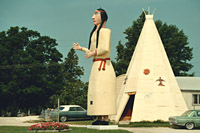 |
Do you see any
connection to her people and their plight at the hands of European
immigrants? Do you get a sense that the young woman loves to commune
with nature and considers the creatures of the earth to be her
friends? Do you see playfulness?
|
|
I would think most
people would say "no" to all those questions. Then I would go on to say
that a dominant culture, such as our white culture which has committed
its own form of genocide against the Native Americans, when it builds a
statue to honor one of their people, should do so in a way that exudes
at least a few of the qualities listed above. Otherwise, the statue
portrays no sense of the Indian maiden's humanity and is not an honor
but a debasement.
The women in the
debate at the Olson party said the Princess Pocahontas statue was in the
same genre as the statue of Paul Bunyan near Bemidji, MN and of Albert
the Bull in Audubon, IA and wondered why I was more critical of
portrayal of Pocahontas than Paul or Albert. First, I would say that
neither Paul nor Albert fall into a category of an oppressed culture
being interpreted by a dominant culture. Two, I would say that the
statues of both Paul and Albert have more redeeming qualities than that
of the Princess statue. So there, I have said my two cents about the
Princess Statue.
I also found
myself in a conversation with Sky at dinner with the Olson family at
the Chateau. I asked if the senior girls would be wearing white and
the boys red for graduation.
|
|
 |
He said they would be and that
they were proud of the tradition and that it had nothing to do with
gender bias. I call the practice a form of gender apartheid, and
although I have seen the tradition in many schools, I still do not
think its commonness makes it appropriate.
|
|
Sky felt contrary,
saying that the two colors added visual interest to the day. I jokingly
suggested the school could have two colors by having tie-dyed robes to
which he responded that I could wear a tie-died outfit if I wanted. I
reminded him I had already graduated and didn't care to go through such
a routine again.
When I asked Sky
why the boys always wore the red (what I call warrior red) and the girls
wore white (what I call virgin white as in weddings), Sky exclaimed that
boys like red and girls like white. Whoa! I stepped out of that
conversation. Sky who has been brought up by Libertarian parents and who
is a pretty independent thinker often more critical of the system than
I am was not budging from his allegiance to the school's
tradition. (That's fair enough. It's his graduation, not mine.) However,
the next day when the family was looking at photos of school events,
perhaps a prom, I saw the beautiful, warrior red evening gown of one of
his classmates and suggested to Sky that at least one girl seemed to
like red. He grinned, albeit only slightly, and mumbled something about
my catching him on a generality.
I left the
conversation at that and didn't push on to other of my pet peeves such
as naming the Pocahontas boys' sports teams the "Indians" and the girls'
teams the "Maidens." Why are they not all called the "Indians?" Or
why aren't the boys called the "Braves" or "Warriors" to more closely
parallel the "Maiden" nickname. Or for that matter, howabout the "Boys"
and the "Maidens?" That would be even more parallel. (I've thought about
school nicknames before, too, for instance when Rolfe started girls'
sports in 1959 and called the girls' teams the Rammettes. I never did
like the term. It seemed diminutive, but then it would have been hard to
call the girls' Rams. I guess we could have called ourselves "Sheep,"
but that wasn't macho enough for most people. I can hear the cheer squad
now, "Let's go Sheep" or "Go get 'em, Sheep."
Or imagine a
Homecoming float moving down Main
Street with a giant, fleecy creature grazing on a green football turf with
a sign saying, "Sheep power." I have to grin at the thought.
|
|
Photo of the Rolfe High School 1956
homecoming parade moving north to south on Garfield Avenue (AKA Main
Street) in Rolfe. The photo is from Superintendent Ralph Mortensen's
collection that is now housed at the
Iowa State University library.) |
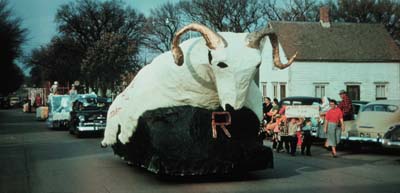 |
|
And
as long as I am listing pet peeves, what about the pairing of senior
girls with senior boys during the commencement recessional? To me,
graduation is a time to put forth our best imagery. (If you
haven't realized it yet, imagery and symbolism are important to me,
perhaps because I am a visual artist. Perhaps because I
realize that our rituals and symbols shape our attitudes and behavior.) Graduation
recognizes the accomplishments of students i.e. earning sufficient
credits in the various required and optional subjects (as well as keeping
in line with the authority system of the school.) It is also a rite of
passage a recognition of youth becoming adults, leaving parents
and families, and in most cases for rural Iowans today, departing from
their hometowns. The passage has many elements physical, emotional,
spiritual, and intellectual to name a few. Why then, I ask, are there
different colors for the boys and girls? Why not view the seniors as
complex humans going through this ritual rather than by gender? And why
the pairing of boy and girl couples for the recessional? Is graduation in
some way modeling marriage? There are many ways to live out our lives.
Sure, I know that most people choose heterosexual marriages, but some enjoy single lives, some
join monastic orders, and the list of wholesome options goes on. I haven't been to many collegiate graduations
lately, but I don't believe they conduct their ceremonies with gender
color differentiation and male/female coupling of the graduates. And I've
heard that hospital nurseries no longer wrap the baby girls in pink and
the boys in powder blue. Most
people I talk to about these things don't see the issues my way, so I
accept the fact that mine are somewhat solo views. However, I wish that
people were less defensive and loyal to what they call tradition. (When I
was at RHS, we all wore gray robes so just when did the dual color
system of Rolfe's red and gold or Poky's red and white come into being for
commencement?) I wish instead
that people were more willing to explore the nuances of the issues and to
come up with creative solutions that would blend past symbolism with new
imagery and be the basis for the traditions
practiced by future senior classes. How
does this relate to the song "No Man is an Island?" Well, when I
walked to my car in the chilly rain, feeling isolated with my minority
thoughts and a bit like a foreigner (or an island in the sea of people at
the commencement services), it was good to be reminded of how we are all
connected and part on the same
fabric. And if I want people to know me for who I am rather than
judging me by stereotypes, then I need to look at the stereotypical ways
in which I judge other people. The people of Pocahontas County and of the
PAC school system are complex humans with many elements physical,
emotional, spiritual, and intellectual to name a few. I can offer my
views but also admit that I am not in a position to know what's best for
their people. There was
another way the song "No Man is an Island" was significant. |
|
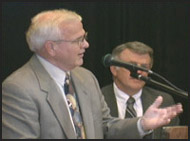 |
The
commencement addresses, especially the one by
Superintendent
Dennis Pierce, emphasized the achievements of the senior class. It's
great to extol such remarkable achievements, and as the
Superintendent often said, they were "Amazing!" |
|
It's hard for me to fathom those numerous and esteemed
accomplishments, and I too, say, "Amazing!" |
|
I also recall a few years ago when the PACS high school
principal spoke at graduation and told how great the seniors were as
competitors. I wish I had the text of that speech to count the number of
times he used the words compete, competition, or competitors. A spirit of
competition is good, but I wondered why a spirit of cooperation was not
also extolled. Certainly in a class of some 70 students, there would be
some whose mode of living is more one of cooperation that competition.
When Superintendent
Pierce said this year, "but whats most important of all? Is that
you excelled in the academics. Your class graduates three Iowa scholars
and one national merit scholar. Fifty-six out of 68 of you graduating
today are going on to further their education," I wondered what it
felt like to be one of the 12 students not enrolled in an advanced
education program.
(By the way, it was
pretty cool to see that the quote of the day in the New York Times today
was a remark by President Bush when he addressed the Yale graduating class
and said that even the C students could some day be President of the
United States.)
I think of the
parade of people who have graduated from the Rolfe schools. I wonder how
many feel at home with themselves and in the world. Some alumni have no
further education than their high school degrees and some have not veered far from their hometown but have have simple jobs they
do with diligence. I don't know their inner lives, but some of these
people seem at
home with themselves and the world, and I envy their dispositions. I also know a
brilliant set of twins who
graduated a few years ahead of me in the 1950's and excelled at academics
but whose lives ended
tragically. At least one, if not both, never achieved the success expected
of him because he seemingly was never able to feel at home with
himself.
How does this relate to
the song "No Man is an Island?" Well, there seems to be a
heavy emphasis on a certain kind of success in our schools. However, just as aeronautical
engineers need pilots and pilots need air traffic controllers, and
airports needs ground
crews (you know the people who wave the flashlights to direct a plane to
the terminal) and mechanics, and those who travel by plane want dependable
baggage handlers, so does every state director of
education needs school superintendents who need teachers, bus
drivers, cooks, custodians, media specialists, nurses, secretaries,
parents and students. No
matter what our skills and potential for success in terms of educational
degrees, income, or accolades no one is an island unto him or herself we need one another to get
our work done and for personal support. |
|
 |
I think the people
of the Pocahontas schools know that. I hear bits and pieces about the mock
trial program from Sylvia who tells me that true teamwork and building trust are big factors in the program's tradition
of success. |
|
However, at commencement, I
would like a balance to hear as much about cooperation as I do
about competition. I would also like to hear about elements of the
educational experience that are not generally touted.
Was there a day when
a student had a wonderful aha when finally learning to write a haiku? Was
there an amazing revelation when a student realized writing his life story
was important? What there a time when a late-blooming student began to take school
seriously because cooking was her main aptitude, and her teacher took a special
interest in helping her learn about food and nutrition? Was there a
time when a student began to take physics or math more seriously because
he discovered the subject matter would help him be a better car mechanic?
Was there an exceptional sense of compassion and camaraderie modeled by
special education students whose graduation is in every way as significant
as that of the straight A students or others who wear the gold ribbons and
honors medals.
I've heard a story about runners in a Special Olympics race that goes
something like this. The lead runners are into the final stretch of the
race when
they turn and see that another runner has fallen. Instead of forging ahead
across the finish line to "win" or be "number one," they return to the
fallen boy, help him to his feet, and all the runners cross the finish
line together. I am moved every time I hear the story because their act
not only affected themselves, but a spirit moved through the arena,
in an electric way, touching and inspiring the fans who stood to applaud the magnificent
act of compassion and cooperation.
There are many examples that could be incorporated into a commencement speech
especially one by an administrator who can see things from a veteran
educational perspective. In that way, commencement
could indeed be about the complexity of the graduates with their many
elements physical, emotional, spiritual, and intellectual. Otherwise,
in one of the biggest annual rituals that a community holds, we end up
praising competition and academics in a way that may symbolize that those
qualities are
all that is needed for success. A competitive
spirit and academic achievement are important, but they are not
everything, and they should not be the only driving forces for a school or
its commencement exercises.
|
|
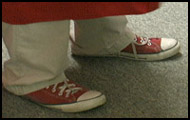 |
It's important that, "No man is an island" wafts into
our souls occasionally. Among other things, it reminds us that
neither Rolfe nor Poky are isolated entities, nor are we as individuals
separate from each other. |
|
Our county is losing
population as fast as any place in the nation, our state's rural
economy is weak, and in many ways, rural issues and urban issues are
two sides of the same coin. I could recall some of the words to the song but not all
of them, so I searched the Internet. I hadn't realized the search would be
as complex with so many published uses of the line, "no man is an
island." Fortunately, however, I finally found a site
with the full lyrics and links to three different recordings in MP3
file format of the words written by Joan Whitney and Alex Kramer. The
first eight lines are what waft through my mind the most.
No man is an island,
No man stands alone,
Each man's joy is joy to me,
Each man's grief is my own.
We need one another,
So I will defend,
Each man as my brother,
Each man as my friend.
I also stumbled onto a site with the full text of a
well-studied sermon
by John Donne (1572-1631) whose
familiar paragraph is:
"No man is an
island, entire of itself, every man is a piece of the continent, a part of
the main. If a clod be washed away by the sea, Europe is the less, as well
as if a promontory were, as well as if a manor of thy friend's or of thine
own were: any man's death diminishes me, because I am involved in mankind,
and therefore never send to know for whom the bell tolls; it tolls for
thee."
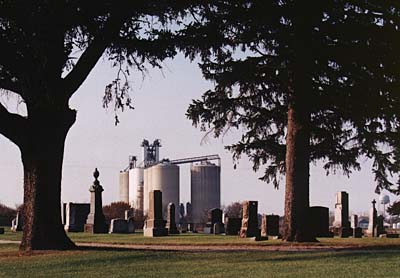
Clinton-Garfield Cemetery southeast of
Rolfe.
Pro Cooperative grain elevators in distance.
Photo by Helen D. Gunderson.

I've said more than my two cents worth. If you want to write your
thoughts and send them to us, we
will post them in the essay section, or you can submit them directly to
the forum page. Or you can join us on
Saturday nights at 9 o'clock Iowa time at our hosted
chat
room.
By
the way, Sky was also a member of the championship mock trial team and was
the only National Merit Scholar from Poky. That's a terrific
accomplishment considering that he and his younger brother Grant (a PACS
sophomore) are partially home-schooled. During most years, the boys have
left Poky and their public schooling in November and gone with their
parents to live on their boat in the Bahamas, returning in the early
spring to resume school with Ben and Sylvia preparing to plant their
corn and bean crop.
Grant also participated on a PACS mock trial team that
placed high at state and was one of two students in that meet given an
award as an outstanding attorney. Grant loves to draw cartoons, and according to his
mom, has some jokes about Rolfe that I wouldn't appreciate. And from what I
personally have heard of Grant's dry satire, I know I don't want to ask to
hear them. He's a great kid even if he doesn't fully
appreciate that town 12 miles northeast of Poky that is diminishing faster
than the county seat town. And we get along fine. We even spent a morning
facing each other from opposite sides of the glass, washing windows at the Olson home in preparation for
Sky's graduation reception that afternoon. And we had fun while we
were at it.
|
|